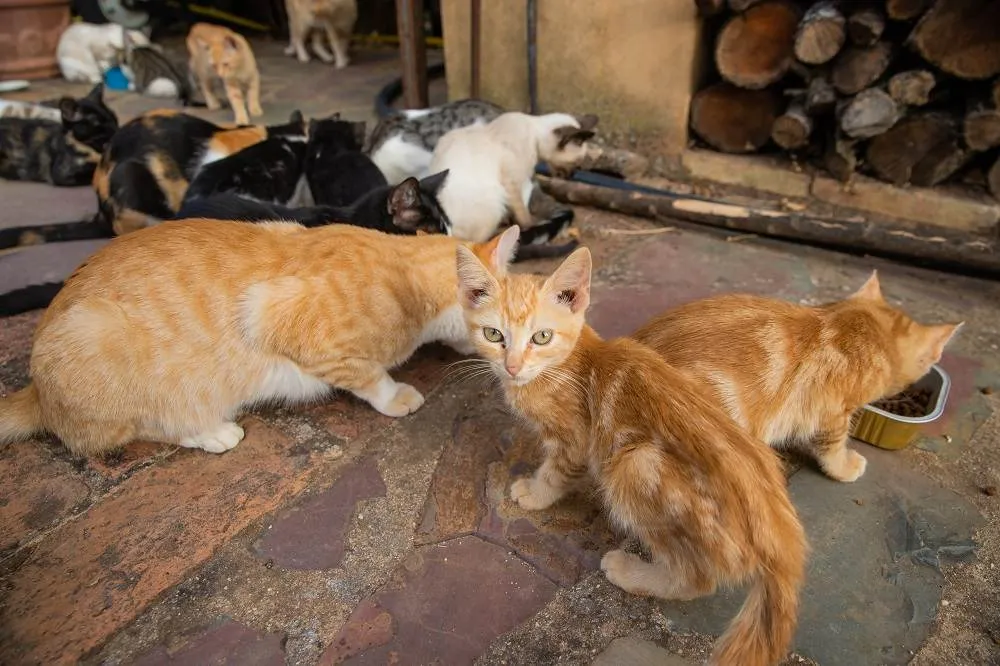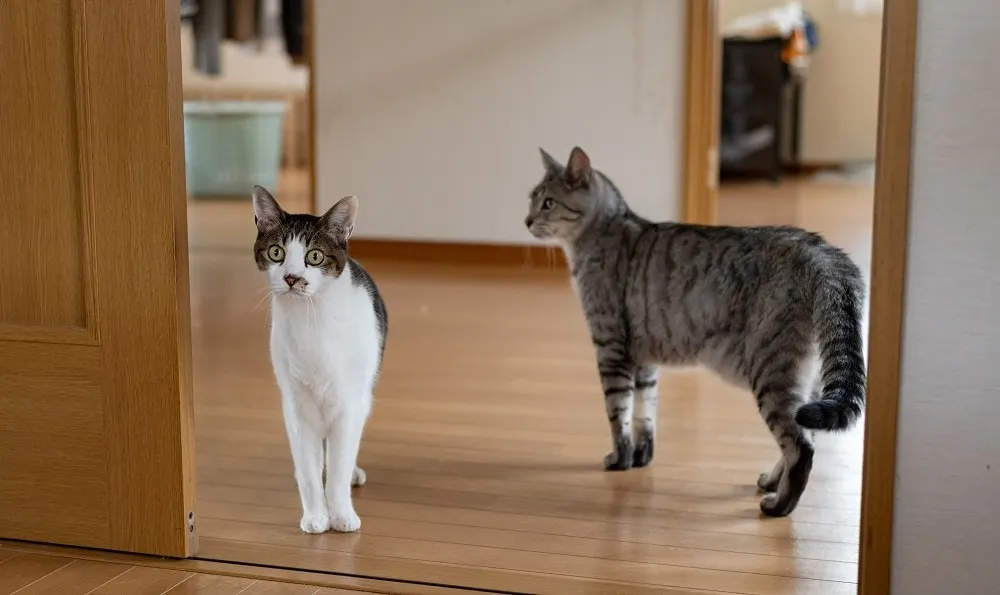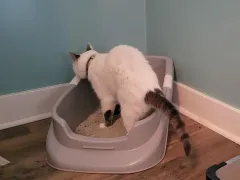Many cat owners observe their felines exhibiting assertive traits—claiming prime nap spots, monopolizing food dishes, or initiating interactions with other pets or humans. These behaviors often lead to questions about a cat’s dominance, particularly concerning what might be perceived as “Alpha Female Cat Behavior.” However, applying the concept of an “alpha” to domestic cats, especially to define female cat behavior, is a common misconception that requires a closer look at feline social dynamics. Understanding the true motivations behind a cat’s actions, rather than labeling them with anthropomorphic terms, is key to fostering a harmonious household and meeting your cat’s specific needs.
Debunking the “Alpha” Myth in Felines
The term “alpha cat” is frequently misused to describe felines that display confident or assertive behaviors. This might include chasing other cats, showing aggression towards animals or people, demanding food or attention, or seemingly ignoring owner commands. Historically, the concept of a strict “alpha” hierarchy was believed to be universal across species. However, modern ethology now recognizes this as applicable only to a select few, such as wolves and certain primate species. It’s imperative to debunk this myth for domestic cats to genuinely understand their complex social lives.
Cats and dogs have evolved along vastly different paths, leading to distinct behaviors and social structures. Unlike the pack mentality observed in dogs, cats are inherently independent and highly territorial creatures. They are not driven by a desire to “please” humans or establish a rigid pecking order through force. Instead, their social choices are influenced by their individual experiences, innate sociability, and the accessibility of crucial resources within their environment. When conflict arises, cats typically prefer to avoid confrontation, choosing to disengage rather than fight, unless no other options are available.
Therefore, attributing “alpha female cat behavior” to a feline is a misinterpretation. Cats do not strive to dominate humans or other pets in the same way an “alpha” in a pack might. Rather, their actions are typically driven by instinct, resource guarding, or a response to perceived threats or discomfort. By shifting our focus from misguided labels to understanding and fulfilling our cats’ fundamental needs and desires, we can cultivate stronger bonds and more peaceful cohabitation.
Social Structures in Feral Cat Colonies
To truly grasp domestic cat behavior, we must first examine the social structures of their feral counterparts. Feral cats, living without direct human intervention, form fascinating, largely matrilineal societies known as colonies. Unlike the strict hierarchies seen in species like wolves, these colonies are built upon blood relationships traced through the mother’s lineage. The size and density of these colonies are directly proportional to the availability of food sources. In environments where food is scarce, cats may even revert to a solitary existence, revealing their innate capacity for independence.
A hallmark of the cat colony is the remarkable cooperation among adult females in the collective care and rearing of kittens. This collaborative effort includes communal nesting, mutual grooming, and joint protection of the young. This collective dynamic among females forms the fundamental social fabric of the colony. While intact males may be associated with a specific colony or have overlapping territories with several, their social integration differs significantly. Dominant males often maintain larger territories than female groups, and while amicable interactions can occur between sexes when familiar, hunting is a solitary activity never shared within the colony.
Cats within a colony possess a keen ability to distinguish between group members and outsiders. Social cohesion is maintained through affiliative behaviors such as nose-touching, allorubbing (rubbing against each other), allogrooming (mutual grooming), and sleeping in close proximity. These friendships transcend gender, observed between males, females, or mixed pairs. Aggression among colony members is generally uncommon. Hostilities typically emerge when male kittens reach sexual maturity and are excluded, or between males and females when a male “patrols” his territory. Interestingly, males are rarely aggressive toward females; instead, sexually receptive females often instigate antagonism towards males that approach too closely. Members of a colony usually exhibit aggression towards unfamiliar cats, highlighting their territorial nature. However, individual cats might struggle to form friendly bonds even within a colony, potentially leading to conflicts over shared resources.
 A group of feral cats sharing dry food provided by caregivers, showcasing cooperative social feeding dynamics.
A group of feral cats sharing dry food provided by caregivers, showcasing cooperative social feeding dynamics.
Understanding Feral Cat Hierarchies and Communication
While not a rigid “alpha” system, feral cat hierarchies are a nuanced interplay of age, sex, personality, and kinship. Older females often hold a higher “ranking,” granting them preferential access to vital resources. The daily access to resources for other colony members is fluid and can change frequently. Intact males, typically not residing within a colony, maintain a looser hierarchy, with the largest male often being the most assertive, followed by others in a less defined order.
Research indicates that feral cat groups exhibit a social feeding hierarchy. Generally, males eat before females, and older, larger felines consume food before smaller, younger ones. Kittens, however, are given priority in feeding by both adult females and males within their group. This demonstrates a nurturing aspect that contradicts a simple dominance model.
Reproductive status also influences this ever-changing social order. Females become fiercely protective of their offspring, while intact males might assert dominance through urine marking and increased aggression during mating seasons. Cats communicate their intentions through a range of subtle signals. A dominant cat might stare directly at a subordinate, which will typically avert its gaze. Assertive cats may stiffen their bodies and rotate their ears forward, while submissive cats flatten or lower their ears. Tail posture is also crucial: a dominant cat might elevate the base of its tail and stiffen its limbs, while a docile cat curls its tail against its thigh or crouches low. Dominant cats often stand tall, whereas subordinates might roll over to show deference. Feral colonies also employ vocalizations and olfactory cues, such as urine and feces, to convey both friendly and aggressive messages. This subtle form of dominance helps cats navigate their group, indicating whom to approach, whom to avoid, and the appropriate timing and context for these interactions.
Dynamics of Multi-Cat Households: Beyond “Alpha Female” Roles
The social dynamics within multi-cat households are constantly evolving, influenced by a myriad of factors including the age, sex, and individual temperament of each cat. For instance, an older cat might show less tolerance for playful kittens, while male cats might exhibit more territorial behaviors. The number of cats, their relatedness, past experiences with other felines, the size of the home, and the amount of personal territory available to each cat all play a significant role in determining overall compatibility and harmony.
While it is often observed that a female cat might appear to be “at the top” of the household’s social structure, this is less about an “alpha female cat behavior” and more about resource management or individual personality. This cat might be the most confident in securing preferred spots or interacting with owners, but it doesn’t imply a hierarchical dominance over all other cats in a forceful way. Instead, some cats may form smaller subgroups, actively avoiding those with whom they don’t get along. Certain cats might assert control over specific areas, defending their core territories. Providing ample space and sufficient resources is paramount in determining whether a multi-cat household thrives in harmony or descends into discord.
Chronic stress can develop in environments where cats lack adequate personal space, preventing them from maintaining a comfortable distance from each other, or if an individual cat is unable to adapt to group living and prefers solitude. Such stress can manifest in behavioral issues like urine spraying, inappropriate elimination outside the litter box, or stress-related health conditions such as feline idiopathic cystitis (FIC) and excessive grooming. Conversely, a confident cat with outdoor access might establish its own perceived territory where resources are plentiful, thereby mitigating these indoor risks.
 Two domestic cats walking past each other in a home, representing the social interactions within a multi-cat household.
Two domestic cats walking past each other in a home, representing the social interactions within a multi-cat household.
Managing Social Interactions and Resource Allocation in Multi-Cat Homes
A cat’s behavior and sociability in a multi-cat household are shaped by genetics, early life experiences, previous exposure to other felines, and the current living environment. Frequent clashes can arise over access to essential resources, as cats are not naturally inclined to share food bowls, resting areas, or toys with other social groups. To alleviate tension and conflict, it is crucial to provide a sufficient number of resources, strategically placed in accessible locations for each cat or social subgroup. A common guideline is the “one resource per cat plus one” formula, distributed throughout the home.
Health issues can significantly impact relationships between cats. Sudden aggression can occur without prior conflict, ranging from mild to severe attacks. For example, an adult female cat suffering from arthritis might lash out at a younger kitten that approaches too closely, especially during colder months when pain might be exacerbated. Group dynamics also shift when a resident cat returns from a veterinary visit or hospitalization, as unfamiliar smells can elicit fear and redirected aggression from other cats.
Disputes are also common during mealtimes or when cats are near critical resources like water bowls, litter boxes, and specific toys. Cats may become aggressive towards each other in these situations. Therefore, providing additional litter boxes, water bowls, and other comforts like warm, raised beds in separate, distinct locations is essential to proactively prevent conflict.
 A domestic cat arching its back, indicating a defensive posture or a stretch.
A domestic cat arching its back, indicating a defensive posture or a stretch.
Conflicts can also erupt when cats from different social groups encounter each other in shared territorial zones. Some cats might actively block access to resources or threaten others to assert control. To minimize these confrontations, it is highly advisable to add multiple hiding spots and ensure at least two clear escape routes in various parts of the home. Owners play a vital role in influencing cat behavior; if a female cat is particularly assertive in certain contexts, more docile male cats might choose to distance themselves from their owners, limiting their lap time and cuddles.
Introducing a new kitten or adult cat into an existing household can significantly disrupt the established hierarchy and group dynamics, potentially leading to aggression. Generally, kittens are more readily accepted into a group than adult cats, but careful, slow introductions are paramount to ensure a smooth and stress-free transition for all felines involved. Ultimately, providing ample enrichment, engaging play, and both mental and physical stimulation can greatly help reduce tension and improve positive group interactions within multi-cat households.
 An empty litter box, emphasizing the need for multiple, accessible litter boxes in multi-cat households to prevent conflict.
An empty litter box, emphasizing the need for multiple, accessible litter boxes in multi-cat households to prevent conflict.
Conclusion
The notion of an “alpha female cat behavior” or an “alpha cat” in general is a widespread myth that oversimplifies the intricate social world of felines. Unlike pack animals, cats operate on complex social structures driven by independence, territoriality, and resource availability, rather than a rigid dominance hierarchy. Understanding the nuanced dynamics of feral colonies and multi-cat households reveals that behaviors often labeled as “alpha” are more accurately interpreted as expressions of confidence, territoriality, or responses to environmental factors and resource competition.
By moving beyond anthropomorphic labels and focusing on providing a rich, resource-abundant, and low-stress environment, cat owners can better understand and meet their cat’s individual needs. Observing your cat’s unique personality and interactions, ensuring ample personal space, and providing sufficient resources are crucial steps toward fostering a truly harmonious home for all felines. Should persistent behavioral challenges arise, consulting with a qualified veterinary behaviorist can provide tailored strategies for intervention and support.
References
- ScienceDirect – Social organisation in feral cats:
https://www.sciencedirect.com/science/article/abs/pii/S016815919601101X - Cats.com – About Us:
https://cats.com/about
